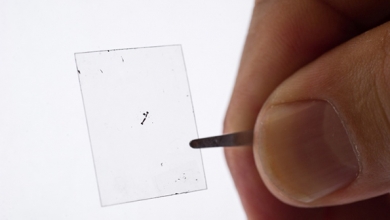A super-slim generator has been constructed out of a few layers of molybdenum disulfide (MoS2) film – each only an atom thick – by engineers at the Georgia Institute of Technology teamed with researchers from Columbia Engineering. The MoS2 generator uses the piezoelectric effect to turn physical stresses and mechanical energy into electricity. This is unusual in that the material in bulk form exhibits no piezoelectric effect because it consists of layers arranged opposite to one another. To make the thin-film generator, the MoS2 had to have an odd number of layers. It also has to be flexed in a certain direction to get current flowing.
 |
| Layers of molybdenum disulfide (MoS2), such as this sample, can be fashioned into light, flexible, and transparent electric generators only a few atoms thick. |
In the experiment, thin flakes of MoS2 were placed on a flexible plastic substrate. The team then placed metal electrodes on the flakes and used them to measure current flow and voltages. The team also noted that the voltage reversed sign when the substrate was flexed in the opposite direction, and it disappeared when they added another layer to give it an even number.
The development opens up new opportunities for piezoelectrics in that MoS2 and other materials will be used to make extremely flexible generators that can be stretched and bent much more than conventional piezoelectric materials, especially ceramics, which are quite brittle. For example, the team envisions integrating flexible devices into clothing that converts the energy from body movements into electricity that can power sensors and medical devices, or recharge cell phones.
